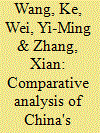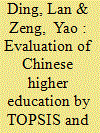|
|
|
Sort Order |
|
|
|
Items / Page
|
|
|
|
|
|
|
| Srl | Item |
| 1 |
ID:
112936


|
|
|
|
|
| Publication |
2012.
|
| Summary/Abstract |
Measuring and improving the energy performance with considering emission constraints is an important issue for China's energy conservation, pollutant emissions reduction and environment protection. This study utilizes several data envelopment analysis (DEA) based models to evaluate the total-factor energy and emission performance of China's 30 regions within a joint production framework of considering desirable and undesirable outputs as well as separated energy and non-energy inputs. DEA window analysis is applied in this study to deal with cross-sectional and time-varying data, so as to measure the performance during the period of 2000-2009. Two treatments for undesirable outputs are combined with DEA models and the associated indicators for simplex energy performance and unified energy and emission performance measurement are proposed and compared. The evaluation results indicate that the treatment of undesirable outputs transformation is more appropriate for China's regional energy and emission performance evaluation because it has stronger discriminating power and can provide more reasonable evaluation results that characterize China's regions. The empirical result shows that east China has the highest and the most balanced energy and emission performance. The energy and emission performance of China remained stable during 2000-2003, decreased slightly during 2004-2006, and has continuously increased since 2007.
|
|
|
|
|
|
|
|
|
|
|
|
|
|
|
|
| 2 |
ID:
126476


|
|
|
|
|
| Publication |
2013.
|
| Summary/Abstract |
Under the dual pressures of an energy crisis and rising greenhouse gas emissions, biomass energy development and utilisation has become part of the national energy strategy in China. The last decade has witnessed a strong promotion of both centralised and decentralised bio-energy systems in rural China. The government seems to have a strong preference for centralised (village-based) bio-energy systems in recent years. However, these government-driven systems have not worked without difficulties, particularly regarding economic and technological viability and maintenance. Studies on the advantages and disadvantages of decentralised and centralised bio-energy systems are rare. This study aims to shed light on the performances of these two systems in terms of social, economic and environmental effects. Through interviewing local officials and village leaders and surveying farmers in 12 villages in Shandong Province, it was found that bio-energy systems should be selected based on the local circumstances. The diversity of the local natural, economic and social situations determines the size, place, technology and organisational model of the bio-energy system.
|
|
|
|
|
|
|
|
|
|
|
|
|
|
|
|
| 3 |
ID:
143379


|
|
|
|
|
| Summary/Abstract |
This study uses techniques for order preference by similarity to ideal solution (TOPSIS) combined with information entropy weight (IEW), to investigate the performance of 68 Chinese universities belonging to the Ministry of Education (MOE) from 2002 to 2011. Assessments in teaching & research, and development ability reflect the short-term and long-term performance respectively. Development ability, consisting of human & physical capital, is an essential determinant, which is hardly found in the former evaluation. The performance of universities suggests that current fiscal expenditure allocation mechanism on Chinese universities is unreasonable, and Chinese higher education as a whole is inefficient. Furthermore, the performance of universities within the eastern region is better than the universities within the central and western regions, and that of the comprehensive universities is better than most specialist universities. Research and development ability largely determine the overall performance of universities. And the superiority and inferiority still co-exist in Chinese universities.
|
|
|
|
|
|
|
|
|
|
|
|
|
|
|
|
| 4 |
ID:
040876


|
|
|
|
|
| Publication |
London, Heinemann, 1972.
|
| Description |
xvi, 180p.Hbk
|
| Standard Number |
434922592
|
|
|
|
|
|
|
|
|
|
|
|
Copies: C:1/I:0,R:0,Q:0
Circulation
| Accession# | Call# | Current Location | Status | Policy | Location |
| 008931 | 658.3125/WIL 008931 | Main | On Shelf | General | |
|
|
|
|
|
|
|
|
|